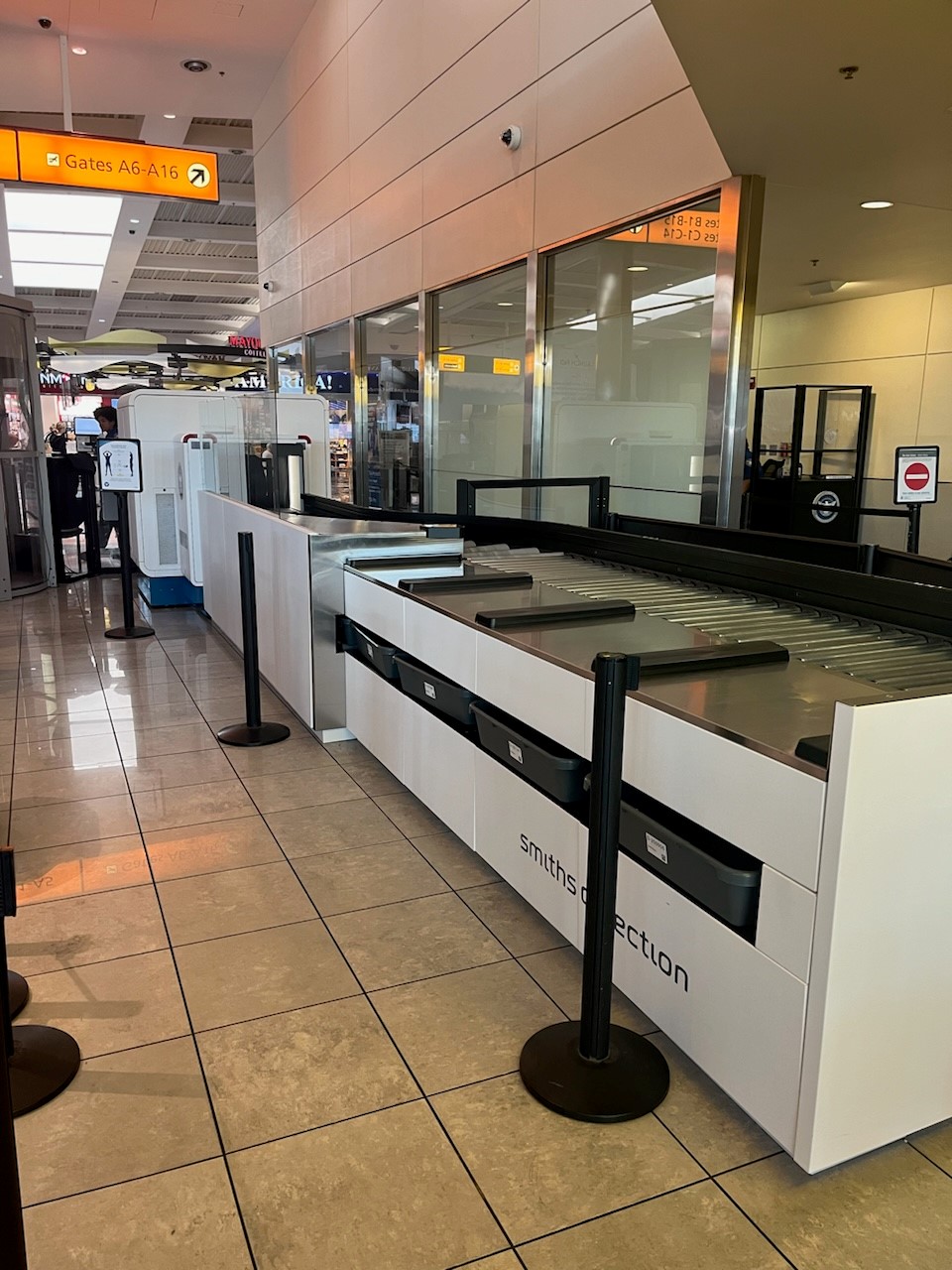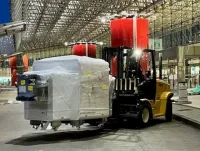 Automated screening lane with a computed tomography scanner (TSA photo)
Automated screening lane with a computed tomography scanner (TSA photo)
LINTHICUM, Md.— The summer travel period has arrived in full force and the Transportation Security Administration (TSA) is prepared for the highest passenger volumes that the agency has ever seen at airport security checkpoints nationwide during this summer’s travel season, which began Memorial Day weekend and runs through Labor Day. In fact, during the course of the past five weeks, TSA has seen several days make it into the top 10 busiest days in TSA’s 22-year history—including the top three days ever.
TSA officials at Baltimore/Washington International Thurgood Marshall Airport (BWI) also expect it to be extremely busy and the agency has been working in close coordination with airport, airline and travel partners to ensure that we are ready for this summer’s increased travel volumes.
On a typical day, TSA screens 27,000 people at the airport checkpoints, but since mid-May, TSA officers at BWI have been screening closer to 33,000 people per day. The busiest times of the day at BWI checkpoints are from 4 to 8 a.m. and from 3 to 7 p.m. Those are the peak hours when the most people are all looking to get through checkpoints to get to their gates around the same time.
“My advice to travelers is to get to the airport early because it will be crowded here and at other airports across the country,” said Christopher Murgia, TSA’s Federal Security Director for Maryland. “By early, I encourage you to arrive at least two hours in advance of your departure time. It will take you longer to find an available parking spot and you can expect to see a line at your airline check-in counter. And that’s before you head to the checkpoint.”
TSA’s second piece of advice is to “know before you go.” By that “I mean to know the contents of your carry-on bag,” Murgia says. “It’s best to begin packing for travel with an empty bag, because that way travelers are less likely to see their carry-on bag trigger an alarm. If you start with an empty bag, you know with certainty that you do not have anything prohibited inside.”
TSA has multiple ways to find out where an item should be packed. You can download the free myTSA app, which has a handy “What can I bring?” feature that allows you to type in the item to find out if it can fly. Or ask on Twitter or Facebook Messenger at @AskTSA. Travelers may also send a question by texting “Travel” to AskTSA (275-872).
“If you have not traveled recently, we want you to be aware of new checkpoint technology units that we have installed here in time for the busy summer travel period,” Murgia added.
TSA has installed automated screening lanes (ASLs) with computed tomography (CT) scanners at the airport checkpoints to enhance security efficiency and decrease the amount of time travelers spend in the security screening process. Installation of the lanes began in late spring.
“We are always looking to incorporate innovative technology throughout the terminal to improve the passenger experience while improving upon our security posture,” Murgia said. “The new screening lanes offer enhanced security as well as an expedited screening experience.”
The CT scanners provide a clear 3-D image of the contents of a traveler’s carry-on bag. Using a touch-screen monitor, TSA officers can rotate the image to get a more complete view of what is inside each bag. In doing so, TSA officers are able to better identify items inside a bag, which results in fewer bags needing to be pulled aside and opened. The 3-D images also enable TSA to better and more quickly identify any threat items that might be contained in carry-on bags.
The ASLs include several new features designed to improve the screening process for travelers going through the security checkpoint including:
- Four divesting countertops per lane designed specifically to enable up to four passengers to place their items in bins simultaneously;
- Automated and powered conveyor rollers that move bins into the X-ray machine tunnel and then feed the bins back to the front of the security checkpoint;
- Automatic diversion of any carry-on bag that may contain a prohibited item to a secure conveyor belt, which allows other bins containing other travelers’ belongings to continue through the screening process uninterrupted;
- Bins that are 25 percent larger than a typical bin and are able to hold a carry-on suitcase;
- Unique Radio Frequency Identification (RFID) tags on each bin, which provides additional accountability of a traveler’s carry-on property as they move throughout the security screening process;
- Cameras that capture digital images of the contents of each bin and are linked side-by-side to the X-ray image of a carry-on bag’s contents to easily match a bag to its X-ray image.
TSA continues to expand the number of automated screening lanes in use at airports across the country. To date, TSA has overseen installation of 205 automated screening lanes in security checkpoints at airports nationwide.
TSA also reminds travelers that starting on May 7, 2025, if you plan to use your state-issued ID or driver’s license to fly within the U.S., make sure you have a REAL ID or another acceptable form of ID. If you are not sure if you have a REAL ID, check with the Pennsylvania Department of Transportation. For questions on acceptable IDs, visit TSA’s web site. “Put REAL ID on your summer to do list,” Johnson recommended.
Travelers can contact TSA with questions may contact TSA by sending a text directly to 275-872 (“AskTSA”) on any mobile device or over social media by sending a message to @AskTSA on X or Facebook Messenger. An automated virtual assistant is available 24/7 to answer commonly asked questions, and AskTSA staff are available 365 days a year from 8 a.m. to 6 p.m. ET for more complicated questions. Travelers may also reach the TSA Contact Center at 866-289-9673. An automated service is available 24/7.
Passengers who need additional assistance through security screening may request a TSA Passenger Support Specialist (PSS). A PSS is a TSA officer who has received specialized training, including how to effectively assist and communicate with individuals with disabilities, medical conditions or those who need additional screening assistance. Individuals should request passenger assistance at least 72 hours in advance by contacting our TSA Cares passenger support line at (855) 787-2227. Live assistance is available weekdays from 8 a.m. to 11 p.m. ET, or weekends and holidays from 9 a.m. to 8 p.m. ET.
TSA encourages all passengers to remain vigilant. If You See Something. Say Something®.
FEMA wants travelers to know how to prepare and stay safe before, during, and after disasters and emergencies— especially while traveling. Hurricanes, flooding, wildfires and extreme heat are common during this time of the year depending on the destination. By understanding the unique hazards in places travelers may go, they can better prepare themselves and their loved ones. There are several things travelers can do to help them and their families stay safe. They can download the FEMA App to receive preparedness tips and weather alerts for up to five different locations; know evacuation zones and evacuation routes so you know how to respond and stay safe during an evacuation order by checking with state and county emergency management offices to learn about local evacuation zones. And they can stay informed by monitoring trusted sources such as local emergency management agencies and the National Weather Service for updates on threat conditions, shelter locations and other important safety information.

